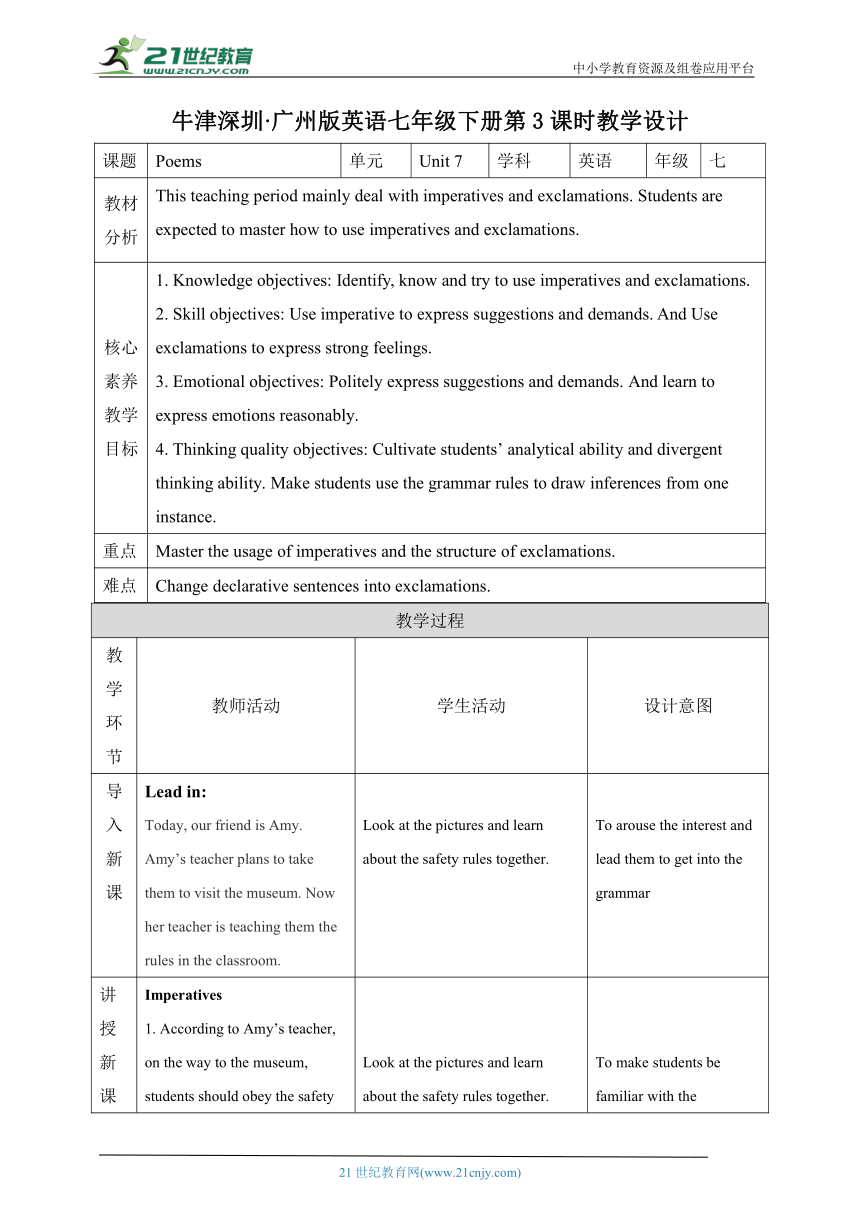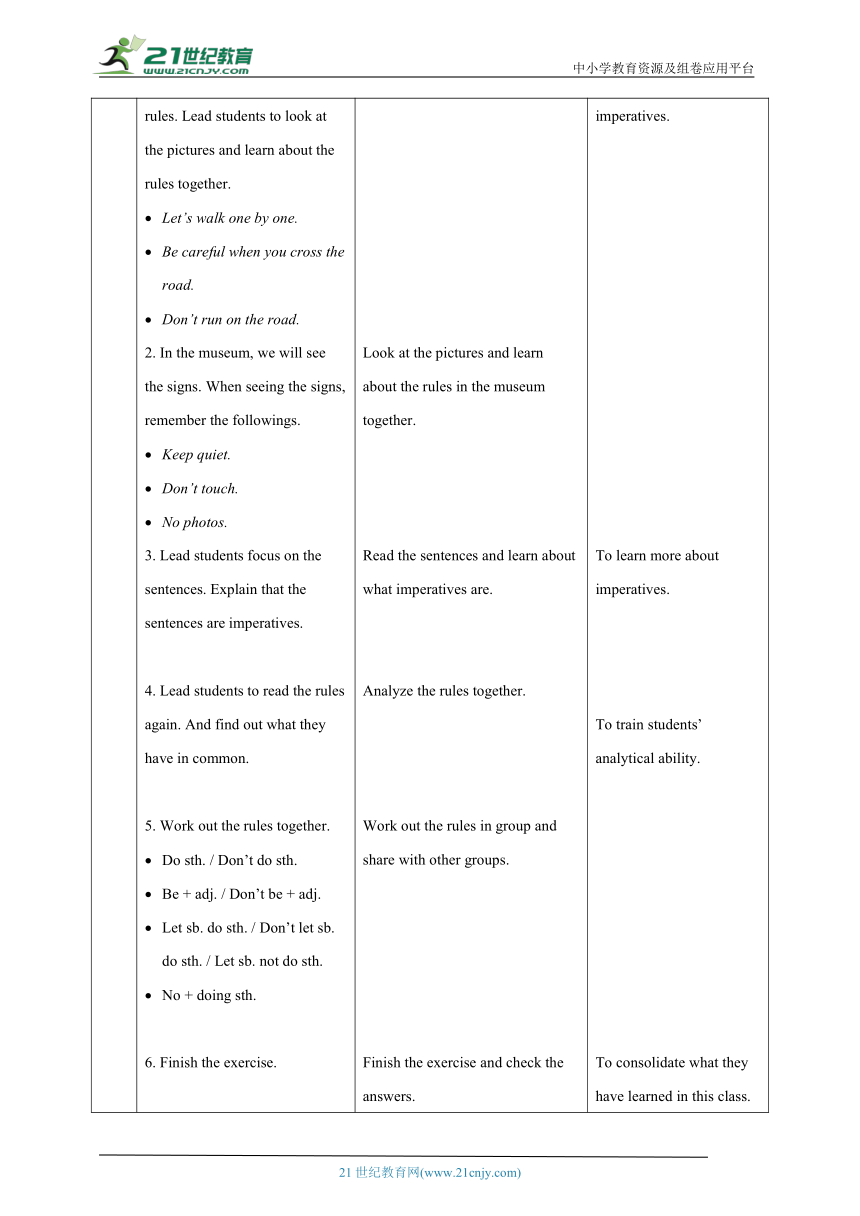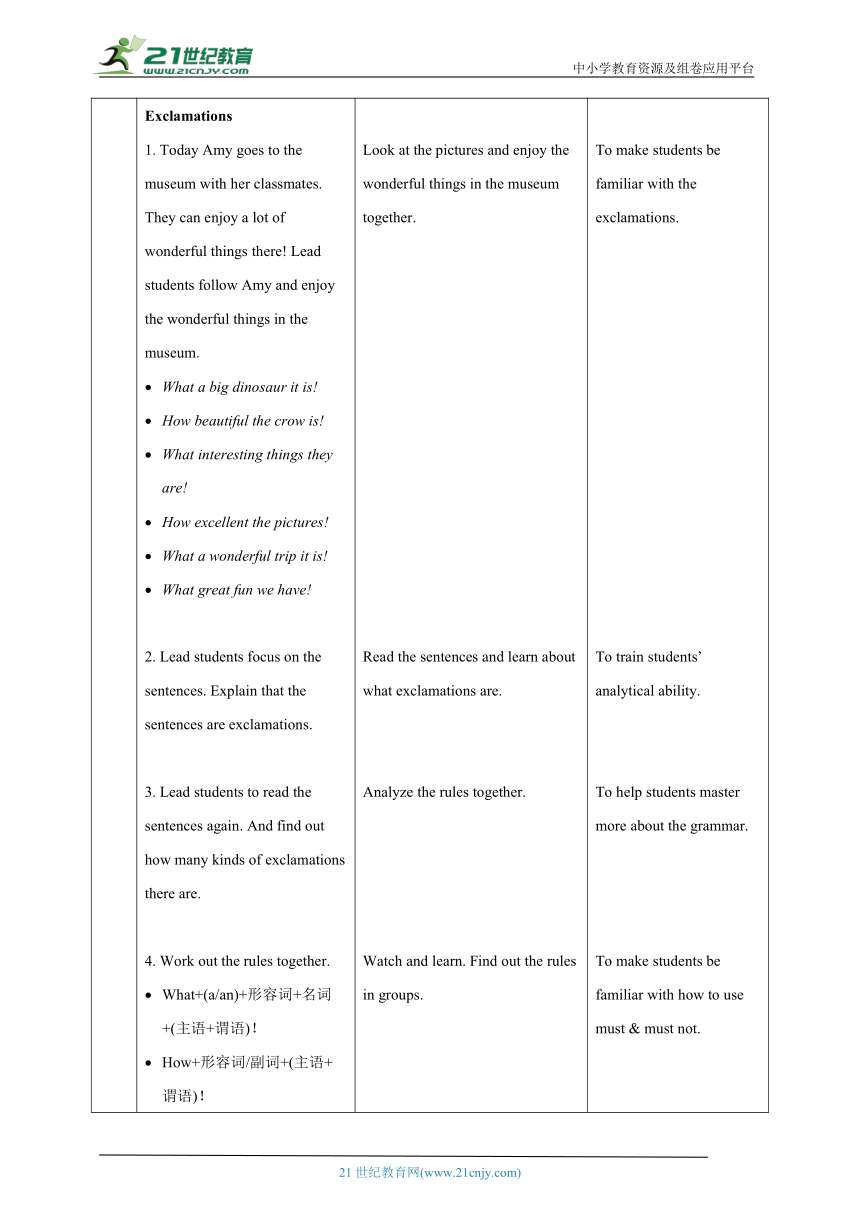【核心素养目标】Unit 7 Poems 第3课时Grammar教案
文档属性
| 名称 | 【核心素养目标】Unit 7 Poems 第3课时Grammar教案 |  | |
| 格式 | doc | ||
| 文件大小 | 1.2MB | ||
| 资源类型 | 试卷 | ||
| 版本资源 | 牛津深圳版 | ||
| 科目 | 英语 | ||
| 更新时间 | 2023-05-05 15:18:58 | ||
图片预览



文档简介
中小学教育资源及组卷应用平台
牛津深圳·广州版英语七年级下册第3课时教学设计
课题 Poems 单元 Unit 7 学科 英语 年级 七
教材分析 This teaching period mainly deal with imperatives and exclamations. Students are expected to master how to use imperatives and exclamations.
核心素养教学目标 1. Knowledge objectives: Identify, know and try to use imperatives and exclamations.2. Skill objectives: Use imperative to express suggestions and demands. And Use exclamations to express strong feelings.3. Emotional objectives: Politely express suggestions and demands. And learn to express emotions reasonably.4. Thinking quality objectives: Cultivate students’ analytical ability and divergent thinking ability. Make students use the grammar rules to draw inferences from one instance.
重点 Master the usage of imperatives and the structure of exclamations.
难点 Change declarative sentences into exclamations.
教学过程
教学环节 教师活动 学生活动 设计意图
导入新课 Lead in:Today, our friend is Amy. Amy’s teacher plans to take them to visit the museum. Now her teacher is teaching them the rules in the classroom. Look at the pictures and learn about the safety rules together. To arouse the interest and lead them to get into the grammar
讲授新课 Imperatives1. According to Amy’s teacher, on the way to the museum, students should obey the safety rules. Lead students to look at the pictures and learn about the rules together.Let’s walk one by one.Be careful when you cross the road.Don’t run on the road.2. In the museum, we will see the signs. When seeing the signs, remember the followings.Keep quiet.Don’t touch.No photos. 3. Lead students focus on the sentences. Explain that the sentences are imperatives.4. Lead students to read the rules again. And find out what they have in common.5. Work out the rules together.Do sth. / Don’t do sth.Be + adj. / Don’t be + adj.Let sb. do sth. / Don’t let sb. do sth. / Let sb. not do sth.No + doing sth.6. Finish the exercise.Exclamations1. Today Amy goes to the museum with her classmates. They can enjoy a lot of wonderful things there! Lead students follow Amy and enjoy the wonderful things in the museum.What a big dinosaur it is!How beautiful the crow is!What interesting things they are!How excellent the pictures!What a wonderful trip it is!What great fun we have!2. Lead students focus on the sentences. Explain that the sentences are exclamations.3. Lead students to read the sentences again. And find out how many kinds of exclamations there are.4. Work out the rules together.What+(a/an)+形容词+名词+(主语+谓语)!How+形容词/副词+(主语+谓语)!5. Summarize the usage of exclamations together.6. Finish the exercise. Look at the pictures and learn about the safety rules together.Look at the pictures and learn about the rules in the museum together.Read the sentences and learn about what imperatives are.Analyze the rules together. Work out the rules in group and share with other groups.Finish the exercise and check the answers.Look at the pictures and enjoy the wonderful things in the museum together.Read the sentences and learn about what exclamations are.Analyze the rules together. Watch and learn. Find out the rules in groups. Summarize the usage of exclamations and take notes.Finish the exercise and check the answers. To make students be familiar with the imperatives.To learn more about imperatives.To train students’ analytical ability.To consolidate what they have learned in this class.To make students be familiar with the exclamations.To train students’ analytical ability.To help students master more about the grammar.To make students be familiar with how to use must & must not.To consolidate what they have learned in this class.To consolidate what they have learned in this class.
课堂小结 本课学生学习了祈使句的功能和用法,学会使用祈使句的肯定式或否定式来表达命令或建议。 同时,学生学习了用What和How构成的感叹句来表达强烈的情感。
板书 祈使句祈使句是表示命令、要求、警告、劝告、禁止、建议、鼓励、请求等语气的句子。其主语常为第二人称且常常省略(Let’s ... 除外)。在祈使句中,为了缓和语气,使表达更委婉、有礼貌,常常在句首或句末加上please。在英语口语中,当祈使句用来表达命令、要求时,用降调;当祈使句用来表达鼓励、请求,或者想使语气委婉一些,让人容易接受时,通常用升调。【祈使句的句式】肯定式1. 动词原形(+宾语)+其他成分.2. Be +表语(名词或形容词)+其他成分.3. Let’s +动词原形+其他成分.否定式1. Don’t / Never +动词原形(+宾语)+其他成分.2. Don’t / Never + be +表语(名词或形容词)+其他成分.如:Please open your books. 请打开你们的书本。Be patient with the blind. 对待盲人要有耐心。Let’s go for a walk. 我们去散步吧。Don’t eat on the bus. 不要在公交车上吃东西。Don’t be late for class. 上课不要迟到。感叹句感叹句是用来表达赞美、惊叹、喜悦等强烈情感的句子。通常由what或how引导,句末多用感叹号。【感叹句的用法和句式】引导词用法句式what对句子中的名词表示感叹1. What + a / an +形容词+可数名词单数(+主语+谓语)!2. What +形容词+不可数名词/可数名词复数(+主语+谓语)!how对句子中的形容词和副词表示感叹1. How +形容词/副词(+主语+谓语)!2. How +主语+谓语!如:What a beautiful flower (it is)! 这朵花真漂亮啊!What nice weather it is today! 今天天气真好!What wonderful gifts you gave me! 你们给我的礼物真是精美!How old a coat it is! 多旧的一件大衣啊!How happily they are playing! 他们玩得多开心啊!How time flies! 光阴似箭!须注意:在英语口语中,由what引导的感叹句中的主语、谓语,甚至形容词有时可省略,如:What clean water! What an orange!等。同样地,由 how 引导的感叹句有时也可省略主语和谓语,如:How lovely! How kindly!等。除了这两种句式外,英语中还可以用其他方式表示感叹,如:运用语气词:Ah! Wow!等;运用单词或短语:Great! Good! Very interesting!等;运用简短的句子:She sings wonderfully!等。
21世纪教育网 www.21cnjy.com 精品试卷·第 2 页 (共 2 页)
HYPERLINK "http://www.21cnjy.com/" 21世纪教育网(www.21cnjy.com)
牛津深圳·广州版英语七年级下册第3课时教学设计
课题 Poems 单元 Unit 7 学科 英语 年级 七
教材分析 This teaching period mainly deal with imperatives and exclamations. Students are expected to master how to use imperatives and exclamations.
核心素养教学目标 1. Knowledge objectives: Identify, know and try to use imperatives and exclamations.2. Skill objectives: Use imperative to express suggestions and demands. And Use exclamations to express strong feelings.3. Emotional objectives: Politely express suggestions and demands. And learn to express emotions reasonably.4. Thinking quality objectives: Cultivate students’ analytical ability and divergent thinking ability. Make students use the grammar rules to draw inferences from one instance.
重点 Master the usage of imperatives and the structure of exclamations.
难点 Change declarative sentences into exclamations.
教学过程
教学环节 教师活动 学生活动 设计意图
导入新课 Lead in:Today, our friend is Amy. Amy’s teacher plans to take them to visit the museum. Now her teacher is teaching them the rules in the classroom. Look at the pictures and learn about the safety rules together. To arouse the interest and lead them to get into the grammar
讲授新课 Imperatives1. According to Amy’s teacher, on the way to the museum, students should obey the safety rules. Lead students to look at the pictures and learn about the rules together.Let’s walk one by one.Be careful when you cross the road.Don’t run on the road.2. In the museum, we will see the signs. When seeing the signs, remember the followings.Keep quiet.Don’t touch.No photos. 3. Lead students focus on the sentences. Explain that the sentences are imperatives.4. Lead students to read the rules again. And find out what they have in common.5. Work out the rules together.Do sth. / Don’t do sth.Be + adj. / Don’t be + adj.Let sb. do sth. / Don’t let sb. do sth. / Let sb. not do sth.No + doing sth.6. Finish the exercise.Exclamations1. Today Amy goes to the museum with her classmates. They can enjoy a lot of wonderful things there! Lead students follow Amy and enjoy the wonderful things in the museum.What a big dinosaur it is!How beautiful the crow is!What interesting things they are!How excellent the pictures!What a wonderful trip it is!What great fun we have!2. Lead students focus on the sentences. Explain that the sentences are exclamations.3. Lead students to read the sentences again. And find out how many kinds of exclamations there are.4. Work out the rules together.What+(a/an)+形容词+名词+(主语+谓语)!How+形容词/副词+(主语+谓语)!5. Summarize the usage of exclamations together.6. Finish the exercise. Look at the pictures and learn about the safety rules together.Look at the pictures and learn about the rules in the museum together.Read the sentences and learn about what imperatives are.Analyze the rules together. Work out the rules in group and share with other groups.Finish the exercise and check the answers.Look at the pictures and enjoy the wonderful things in the museum together.Read the sentences and learn about what exclamations are.Analyze the rules together. Watch and learn. Find out the rules in groups. Summarize the usage of exclamations and take notes.Finish the exercise and check the answers. To make students be familiar with the imperatives.To learn more about imperatives.To train students’ analytical ability.To consolidate what they have learned in this class.To make students be familiar with the exclamations.To train students’ analytical ability.To help students master more about the grammar.To make students be familiar with how to use must & must not.To consolidate what they have learned in this class.To consolidate what they have learned in this class.
课堂小结 本课学生学习了祈使句的功能和用法,学会使用祈使句的肯定式或否定式来表达命令或建议。 同时,学生学习了用What和How构成的感叹句来表达强烈的情感。
板书 祈使句祈使句是表示命令、要求、警告、劝告、禁止、建议、鼓励、请求等语气的句子。其主语常为第二人称且常常省略(Let’s ... 除外)。在祈使句中,为了缓和语气,使表达更委婉、有礼貌,常常在句首或句末加上please。在英语口语中,当祈使句用来表达命令、要求时,用降调;当祈使句用来表达鼓励、请求,或者想使语气委婉一些,让人容易接受时,通常用升调。【祈使句的句式】肯定式1. 动词原形(+宾语)+其他成分.2. Be +表语(名词或形容词)+其他成分.3. Let’s +动词原形+其他成分.否定式1. Don’t / Never +动词原形(+宾语)+其他成分.2. Don’t / Never + be +表语(名词或形容词)+其他成分.如:Please open your books. 请打开你们的书本。Be patient with the blind. 对待盲人要有耐心。Let’s go for a walk. 我们去散步吧。Don’t eat on the bus. 不要在公交车上吃东西。Don’t be late for class. 上课不要迟到。感叹句感叹句是用来表达赞美、惊叹、喜悦等强烈情感的句子。通常由what或how引导,句末多用感叹号。【感叹句的用法和句式】引导词用法句式what对句子中的名词表示感叹1. What + a / an +形容词+可数名词单数(+主语+谓语)!2. What +形容词+不可数名词/可数名词复数(+主语+谓语)!how对句子中的形容词和副词表示感叹1. How +形容词/副词(+主语+谓语)!2. How +主语+谓语!如:What a beautiful flower (it is)! 这朵花真漂亮啊!What nice weather it is today! 今天天气真好!What wonderful gifts you gave me! 你们给我的礼物真是精美!How old a coat it is! 多旧的一件大衣啊!How happily they are playing! 他们玩得多开心啊!How time flies! 光阴似箭!须注意:在英语口语中,由what引导的感叹句中的主语、谓语,甚至形容词有时可省略,如:What clean water! What an orange!等。同样地,由 how 引导的感叹句有时也可省略主语和谓语,如:How lovely! How kindly!等。除了这两种句式外,英语中还可以用其他方式表示感叹,如:运用语气词:Ah! Wow!等;运用单词或短语:Great! Good! Very interesting!等;运用简短的句子:She sings wonderfully!等。
21世纪教育网 www.21cnjy.com 精品试卷·第 2 页 (共 2 页)
HYPERLINK "http://www.21cnjy.com/" 21世纪教育网(www.21cnjy.com)
